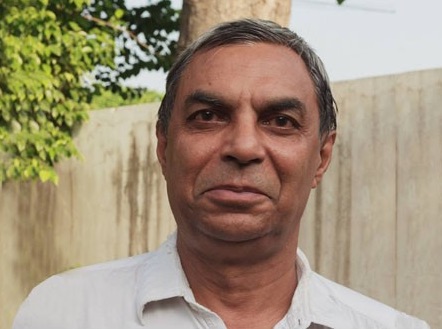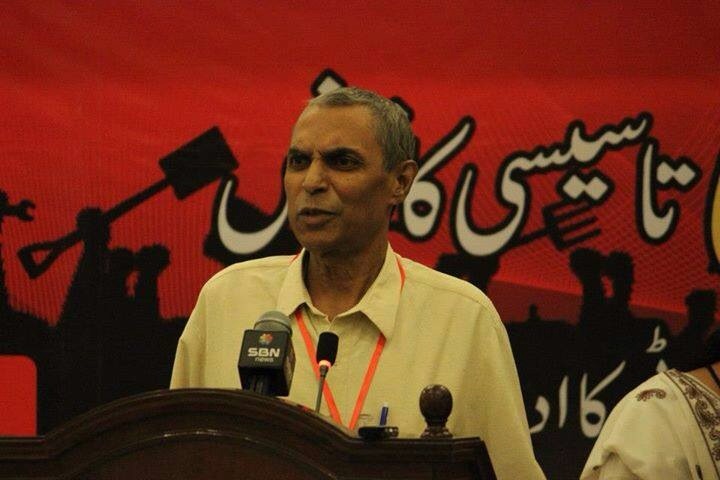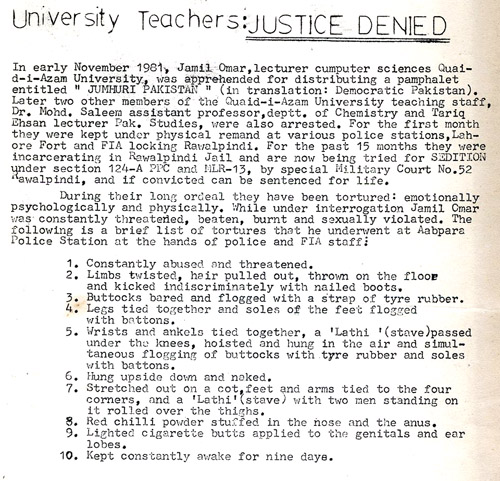Jamil Omar’s revolutionary road
Aamir Riaz
 “Judgment comes from experience, and experience comes from bad judgments”. A puritan may have some problems with the quote. The fact remains that learning from your mistakes is an art and we often miss it because of our pride or prejudices.
“Judgment comes from experience, and experience comes from bad judgments”. A puritan may have some problems with the quote. The fact remains that learning from your mistakes is an art and we often miss it because of our pride or prejudices.
Jamil Omar was a committed soul. Born on August 1, 1952, he was grandson of Khalifa Nooruddin who earned great respect not only in his community but also among the intellectual elite of the early 20th century in our region. Like his grandfather, Jamil had the courage to carve his own way. Yet he was well-aware of the Nooruddin family legacy and lineage scattered from Bhera to Lahore.
After completing his high school from the elitist Aitchison College Lahore, Jamil joined BSc honours (a three-year degree course) in the Punjab University in 1970 where his subjects were English, Physics and double Maths. At that time, Professor Azizuddin was associated with the English Department at the Punjab University. It was a time when our campuses were sharply divided across Left and Right ideologies with NSO, factions of NSF and PSF representing the Left while Islami Jamiat Talba (IJT) the Right.
Jamil remained politically neutral in those heydays of ideology. He was a supporter of Student Own Power (SOP) (Liberals) whose twist can be smelt in its slogan “Na surkh hai Na sabaz hai/Asia ko Qabaz hai” (loosely translated as “It’s neither red nor green, Asia is constipated”).
After graduation, Jamil earned a Masters degree in Physics from the Punjab University and then joined Quaid-i-Azam University from where he did another Masters, this time in Computer Sciences. From 1970 till 1978, he remained unnoticed by the red revolutionaries due to his skepticism. But he was decidedly opposed to the IJT. Once he told me about his Quaid-i-Azam University days where he supported his Punjabi fellow Sarwar Bari against the IJT who was contesting an election of the student union. At that time, Farzana was with the IJT. Later, Farzana and Sarwar married and remained lifelong friends of Jamil. He even earned criticism when, along with the couple, he openly supported the bogus referendum of General Musharraf in April 2002.
Jamil was a brilliant student and in those days our universities offered lectureships to their bright students. Jamil got lectureship at Quaid-i-Azam University and then, in 1979, he got a one-year scholarship for socialist Romania. Interestingly, the neutral position of socialist Romania in the Sino-USSR conflict moved Jamil towards the Left.
After his return, Jamil Omar was baptised by Professor Azizuddin Ahmad. At that time, the pro-Chinese Professor Group was publishing an underground journal “Jamhoori Pakistan” against General Zia’s martial law. Late Professor Khalid Mahmood was in-charge of the party affairs then in the twin cities of Rawalpindi-Islamabad. Jamil started his new journey as a member of the distribution team entrusted with the task of distributing Jamhoori Pakistan. In late 1981, he was arrested by the military authorities along with two friends. A leaflet named “University Teachers: Justice Denied was also published after 15 months of their arrest, exposing their long ordeal and torture. It says: “While under interrogation, Jamil Omar was constantly threatened, beaten up, burnt and sexually violated”.
It was the worst time not only in Pakistan but also in the whole region. Sect based Islamic revolution in Iran and military intervention of Soviet Union in Afghanistan had already jeopardised the regional balance. In response, the US and Western Europe including Britain along with Saudi Arabia were using the old weapon of Islamic Jihad to counter the ‘atheist’ USSR.
General Zia was smart enough to use that situation in favour of his illegitimate government while Jamaat-e-Islami was enjoying the ride of Islamisation with the dictator. As a sole popular political party opposed to the military regime, the Pakistan People’s Party was under severe attack. The Punjab-based tiny Professor Group was supporting it wholeheartedly, using its traditional underground tactics. The group was formed in late 1960s during the heydays of the Sino-Russian ideological conflict which not only ruined the Left Nationalist forces in Pakistan but also damaged the Left in developing countries as a whole. As numerous professors were hardcore so it gained popularity as “Professor Group”. Prominent among them, other than Azizuddin and Khalid Mahmood, were Munir Ghazanfar (Geology), Dr. Nawaz(Geology), Abdul Shakoor (Geology), Hamid Qizilbash (Political Science) from the Punjab University while Ijaz ul Hassan and Kamil Khan Mumtaz were from the National College of Arts.
After facing torture and humiliation, Jamil was finally released in 1984 partly due to political pressure on the regime and partly due to some personal efforts of family and friends. At that time, the Professor Group started a publishing concern Maktaba-e-Fikr-o-Danish and had close association with a Sindhi left group of Rasool Bakhsh Paleejo. The Professor Group not only failed to develop an alliance with the Punjab-based Left groups, especially the pro-Chinese Mazdoor Kissan Party, but was also unsuccessful in developing its independent identity under the banner of Punjab Jamhoori Front.
In 1986, the group along with its Sindhi comrades, joined the Left-Nationalist alliance under the leadership of Pro-Moscow Khan Abdul Wali Khan. Neither Ghous Bakhsh Bizenjo nor Mahmud Khan Achakzai joined the newly-formed ANP in 1986 (unlike NAP, progressive Baloch and Pakhtoons from Balochistan who did not join that party) as they had severe reservations against the Khans of Charsadda.
Majority of the Left-leaning groups did not join the ANP due to different reasons. But Jamil Omar was very hopeful as he was a staunch supporter of the Left unity. He made a lot of efforts but soon he had to taste inner conspiracies as well as the authoritarian flavour of Charsadda. During the late 1980s and 1990s, the Professor Group tried its luck not only in publishing but also kept moving in different circles under the banner of Left unity — none of these efforts bore success.
The group’s main commissars like Liaqat Ali, Shahid Babu, Rana Abdur Rehman and Zahoor Ahmad formed their own successful publishing concerns because the group had no capacity to absorb them while the magazine of the group Naya Pakistan could not survive after 12 issues due to bad management.
In the 1990s, Jamil joined Oxfam Afghanistan chapter which was at that time based in Islamabad. So he had to visit numerous cities of Afghanistan time and again. Due to his family legacy, he knew Persian very well. Because of his political training, he tried to expand the work on political grounds but he had to stop it because it was beyond the donor’s agenda.
He married Nafeesa, a Tajik woman, who later based herself in Islamabad due to Taliban fiasco. Nafeesa returned to Afghanistan probably after 9/11 which divided the revolutionary once again but this time between Lahore and Kabul. His heart was in Lahore but his love was in Kabul.
 In late 2002, he was among those people who formed the Awami Jamhoori Forum. The Forum was an effort by different progressives and independent intellectuals to create a political space where workers from the Left could debate past politics and move towards a new Left party. For this purpose, the Forum held seminars, arranged lectures and also started a magazine called the Awami Jamhoori Forum (www.ajfpk.org) in 2003. Jamil also wrote for its magazine but his constant movement between Kabul and Lahore remained an irritant.
In late 2002, he was among those people who formed the Awami Jamhoori Forum. The Forum was an effort by different progressives and independent intellectuals to create a political space where workers from the Left could debate past politics and move towards a new Left party. For this purpose, the Forum held seminars, arranged lectures and also started a magazine called the Awami Jamhoori Forum (www.ajfpk.org) in 2003. Jamil also wrote for its magazine but his constant movement between Kabul and Lahore remained an irritant.
His desire for the unity of the Left compelled him to merge the tiny group of Awami Jamhoori Forum with new alliances like Awami Jamhoori Ittehad. Then Jamil Omar formed Awami Party Pakistan (APP) with Fanoos Gujjar of Swat. But the editorial team of AJF remained independent. The editorial team was of the view that for sustainable Left politics, a rethinking process on basic issues and past politics is essential and that in the absence of that process such alliances and mergers would be futile. But Jamil remained adamant and both parties agreed to disagree.
Finally, the APP further merged with the newly-formed Awami Workers Party (AWP). But Jamil Omar was not quite happy even with the new formation. On March 17, he suffered a heart attack which ended another chapter of the unfinished book ‘The Pakistani Left’.
Jamil Omar had a long list of friends — among rich and poor, aristocrats, artists, journalists, technocrats and labourers. He was an admirer of Dada Ameer Haider and Khwaja Masud and had made a film on Dada too. All those who met him could not have ignored his warmth whether they supported his ideas or not.
Now that he is no more, everyone is remembering him not because of his early death but because of the warmth he exuded throughout his life. His family, wife, daughter and friends will miss it, for sure.

